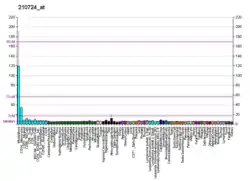EMR3
EGF-like module-containing mucin-like hormone receptor-like 3 is a protein encoded by the ADGRE3 gene.[3][4] EMR3 is a member of the adhesion GPCR family.[5][6] Adhesion GPCRs are characterized by an extended extracellular region often possessing N-terminal protein modules that is linked to a TM7 region via a domain known as the GPCR-Autoproteolysis INducing (GAIN) domain.[7]
| ADGRE3 | |||||||||||||||||||||||||||||||||||||||||||||||||||
|---|---|---|---|---|---|---|---|---|---|---|---|---|---|---|---|---|---|---|---|---|---|---|---|---|---|---|---|---|---|---|---|---|---|---|---|---|---|---|---|---|---|---|---|---|---|---|---|---|---|---|---|
| Identifiers | |||||||||||||||||||||||||||||||||||||||||||||||||||
| Aliases | ADGRE3, EMR3, adhesion G protein-coupled receptor E3 | ||||||||||||||||||||||||||||||||||||||||||||||||||
| External IDs | OMIM: 606101 HomoloGene: 50009 GeneCards: ADGRE3 | ||||||||||||||||||||||||||||||||||||||||||||||||||
| |||||||||||||||||||||||||||||||||||||||||||||||||||
| |||||||||||||||||||||||||||||||||||||||||||||||||||
| |||||||||||||||||||||||||||||||||||||||||||||||||||
| |||||||||||||||||||||||||||||||||||||||||||||||||||
| Wikidata | |||||||||||||||||||||||||||||||||||||||||||||||||||
| |||||||||||||||||||||||||||||||||||||||||||||||||||
EMR3 expression is restricted to monocytes/macrophages, myeloid dendritic cells, and mature granulocytes in human.[8] Transcription of the EMR3 gene results in two alternative spliced forms: a surface protein with extracellular, 7TM, and intracellular domains as well as a truncated soluble form of only the extracellular domain.[9] Mice, next to Emr2, lack the Emr3 gene.[10]
Function
The protein may play a role in myeloid-myeloid interactions during immune and inflammatory responses.[11]
Ligands
A potential ligand of EMR3 likely is expressed on human macrophage and activated neutrophils.[9]
References
- GRCh38: Ensembl release 89: ENSG00000131355 - Ensembl, May 2017
- "Human PubMed Reference:". National Center for Biotechnology Information, U.S. National Library of Medicine.
- Stacey M, Lin HH, Hilyard KL, Gordon S, McKnight AJ (Jun 2001). "Human epidermal growth factor (EGF) module-containing mucin-like hormone receptor 3 is a new member of the EGF-TM7 family that recognizes a ligand on human macrophages and activated neutrophils". The Journal of Biological Chemistry. 276 (22): 18863–70. doi:10.1074/jbc.M101147200. PMID 11279179.
- Hamann, J; Aust, G; Araç, D; Engel, FB; Formstone, C; Fredriksson, R; Hall, RA; Harty, BL; Kirchhoff, C; Knapp, B; Krishnan, A; Liebscher, I; Lin, HH; Martinelli, DC; Monk, KR; Peeters, MC; Piao, X; Prömel, S; Schöneberg, T; Schwartz, TW; Singer, K; Stacey, M; Ushkaryov, YA; Vallon, M; Wolfrum, U; Wright, MW; Xu, L; Langenhan, T; Schiöth, HB (April 2015). "International Union of Basic and Clinical Pharmacology. XCIV. Adhesion G protein-coupled receptors". Pharmacological Reviews. 67 (2): 338–67. doi:10.1124/pr.114.009647. PMC 4394687. PMID 25713288.
- Stacey M, Yona S (2011). Adhesion-GPCRs: Structure to Function (Advances in Experimental Medicine and Biology). Berlin: Springer. ISBN 978-1-4419-7912-4.
- Langenhan, T; Aust, G; Hamann, J (21 May 2013). "Sticky signaling--adhesion class G protein-coupled receptors take the stage". Science Signaling. 6 (276): re3. doi:10.1126/scisignal.2003825. PMID 23695165. S2CID 6958640.
- Araç D, Boucard AA, Bolliger MF, Nguyen J, Soltis SM, Südhof TC, Brunger AT (Mar 2012). "A novel evolutionarily conserved domain of cell-adhesion GPCRs mediates autoproteolysis". The EMBO Journal. 31 (6): 1364–78. doi:10.1038/emboj.2012.26. PMC 3321182. PMID 22333914.
- Matmati M, Pouwels W, van Bruggen R, Jansen M, Hoek RM, Verhoeven AJ, Hamann J (Feb 2007). "The human EGF-TM7 receptor EMR3 is a marker for mature granulocytes". Journal of Leukocyte Biology. 81 (2): 440–8. doi:10.1189/jlb.0406276. PMID 17108056. S2CID 37679823.
- Stacey M, Lin HH, Hilyard KL, Gordon S, McKnight AJ (Jun 2001). "Human epidermal growth factor (EGF) module-containing mucin-like hormone receptor 3 is a new member of the EGF-TM7 family that recognizes a ligand on human macrophages and activated neutrophils". The Journal of Biological Chemistry. 276 (22): 18863–70. doi:10.1074/jbc.M101147200. PMID 11279179.
- Kwakkenbos MJ, Matmati M, Madsen O, Pouwels W, Wang Y, Bontrop RE, Heidt PJ, Hoek RM, Hamann J (Dec 2006). "An unusual mode of concerted evolution of the EGF-TM7 receptor chimera EMR2". FASEB Journal. 20 (14): 2582–4. doi:10.1096/fj.06-6500fje. PMID 17068111. S2CID 16254868.
- "Entrez Gene: EMR3 egf-like module containing, mucin-like, hormone receptor-like 3".


